The Hoh Rainforest is arguably one of the most magical places in the United States.
Picture towering spruce and hemlock trees dripping with thick beards of moss and lichen. Ferns covering the forest floor, and the occasional sound of water dripping through the canopy. Even on well-worn trails, you may come face to face with an elk, or spot salmon in a stream.
The place feels ancient, but smells of fresh air and green plants. It’s like a real-life FernGully.
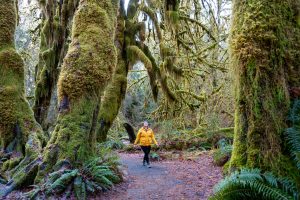
But thankfully this place doesn’t just exist in the imagination or in a movie – it’s a real place on the Olympic Peninsula in Washington State!
What is the Hoh Rainforest?
The Hoh Rain Forest is a temperate rainforest located within Olympic National Park in Washington. It covers about 24 miles today, but once was part of a massive rainforest that stretched along the Pacific coast from Alaska to central California.
The Hoh Rainforest is bordered on one side by the Hoh River, which flows from Mt. Olympus through a valley that was carved out by ancient glaciers. The rainforest (as its name would suggest) is one of the wettest places in the entire United States, receiving on average nearly 140 inches of rain per year.
Partially thanks to the Hoh Rainforest’s uniqueness, Olympic National Park as a whole has also been designated both an International Biosphere Reserve and a UNESCO World Heritage Site.
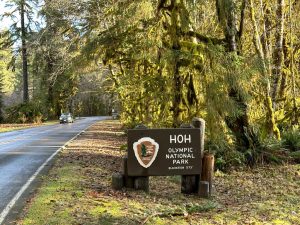
When to visit the Hoh Rain Forest
The Hoh Rainforest is open year-round, and people can and do visit in every month of the year.
Having said that, though, I think there’s a great argument to be made for visiting Hoh during the winter or spring months.
First of all, just because it’s a rainforest doesn’t actually mean that it rains here all the time. In 2022, for example, the Hoh Rain Forest received roughly 110 inches of rain – but more than half of it fell after October 1st!
Summertime in the rainforest can actually be quite dry. So while you might like the idea of hiking in the sunshine, you also run the risk of finding a lot of those incredible mosses and lichens dried up during especially dry summer months.
Plus, Hoh can get so busy during the summer (especially on weekends) that the parking lot is often filled by 10 a.m.
Why visit the Hoh Rainforest in winter
I visited Hoh in winter – on New Year’s Day, in fact – and found it to be an excellent time to visit. Why? Because:
- Fewer people visit in winter – This means easy parking, and not having to worry about running into tons of other people on the trails. (Instead of people, we ran into Roosevelt elk on the trail!)
- Better chance for moody scenes – Part of what makes the Hoh Rain Forest so enchanting is all the moss on the towering trees. And when the forest is dripping (either with rain or just early-morning mist), it’s extra magical. If you want the best chance of epic mossy forest scenes, you want to visit when the forest is the wettest – and that’s usually during the winter.
- Salmon runs! – A surprise for us when we visited on January 1 was that the local Coho salmon were in the middle of a spawning run up one of the smaller tributaries to the Hoh River. Salmon swim upstream here usually November-December, and it’s a cool extra thing to look out for.
Downsides of visiting Hoh Rain Forest in winter
There are a few downsides to visiting the rainforest in winter, of course. Like:
- More of a chance of bad weather – While we had a partially sunny day for our winter visit, you have a much higher chance of encountering cold rain in the winter months. You’ll want to pack/dress accordingly with warm layers and solidly waterproof outer shells and boots. A hat and gloves is a good idea, too, because it can get cold!
- The Visitor Center closes – There’s a small Olympic National Park visitor center next to the Hoh Rain Forest parking lot, where you can see a few small exhibits on life in the forest and see the current year’s rain totals. This visitor center is open daily during the summer, but only Friday-Sunday in the off-season, and is usually completely closed from January 2 through early March. (You can still use the trails when the visitor center is closed, though!)
- Less daylight – Especially if you’re visiting in December or January, you can expect only about 8-9 hours of total daylight each day. If you’re trying to visit the Hoh Rain Forest along with other sites in Olympic NP in one day, you’ll have to hustle!
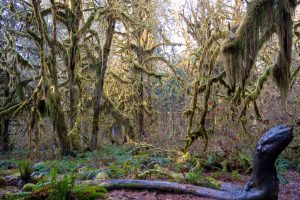
Things to do in the Hoh Rain Forest
There’s really one main thing to do in the Hoh Rainforest: hike. There aren’t any other attractions here beyond the towering mossy trees and nearby mountain vistas, regardless of which season you visit.
All trails start near the visitor center, and note that pets are not permitted on any of them.
1. Hall of Mosses
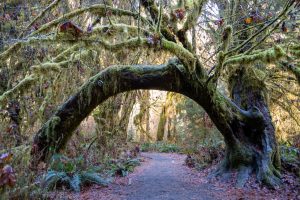
The main, must-see trail in the Hoh Rain Forest is the Hall of Mosses, which is a .8-mile loop through an old growth forest. This is the trail you’ve probably seen the most photos of, where thick moss in every shade of green drapes over crooked tree branches.
Here you can see towering Western Hemlock and Sitka Spruce trees, along with Douglas Firs, Big Leaf Maples, Red Cedars, and more. It’s fun to look for unique shapes in the trees and moss.
Plan for this trail to take you longer to hike than you think, because you’ll be stopping so often for photos!
The Hall of Mosses trail has a few mild uphill sections, and can be very muddy when it’s wet. It’s important to stay on the trail, though, as the mosses, ferns, and other growing things are easily damaged and can take a long time to grow back.
Wear good waterproof boots so you can walk through puddles and muddy spots instead of making new trails around them.
2. Spruce Nature Trail
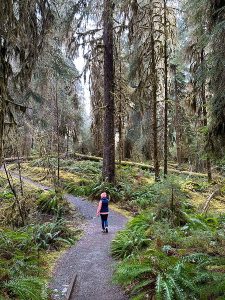
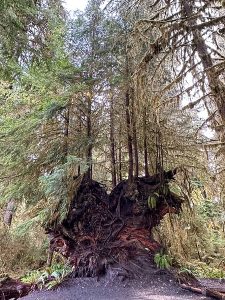
This 1.2-mile-long loop trail traverses through both old and new growth forest. You follow Taft Creek for a while, and eventually reach the bank of the Hoh River. On a nice day, the views at the Hoh River are incredible!
You’ll see less moss along this trail, but can look out for super tall trees and interesting root formations. It was also in Taft Creek that we saw Coho salmon!
3. Hoh River Trail
If you’re in for more of a hike (or if you want to do some overnight, backcountry hiking), then the Hoh River Trail is for you. This out-and-back trail stretches for 18.5 miles, where it terminates at the Blue Glacier moraine at the foot of Mt. Olympus. (You don’t have to hike the whole thing, though!)
If you want to do a multi-day hike on this trail, you may need to get a backcountry permit in order to camp, which you can learn more about here. (Of course, only do this if you’re experienced in the outdoors, especially in winter!)
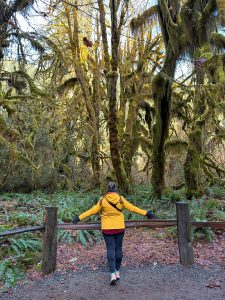
Thanks for reading!

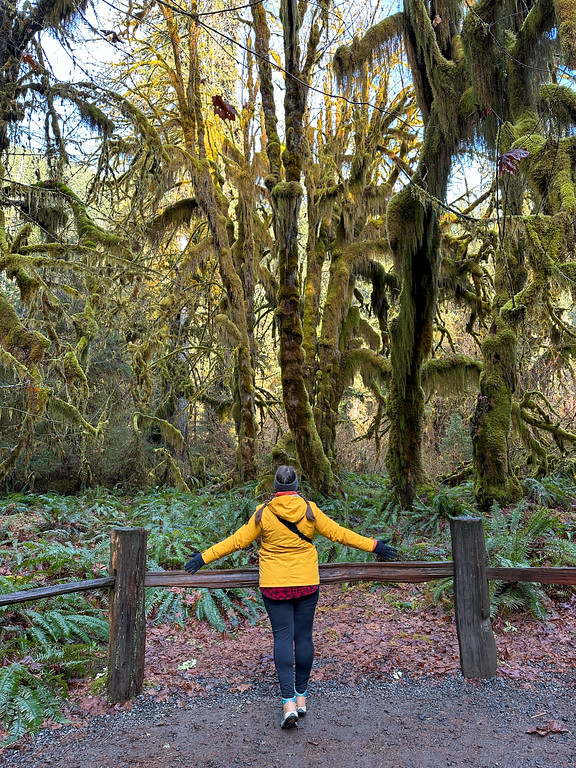
What do you think?
Show comments / Leave a comment